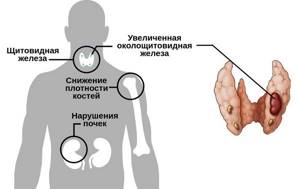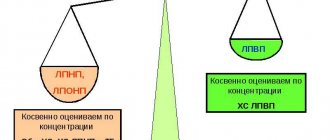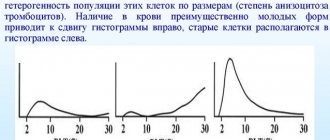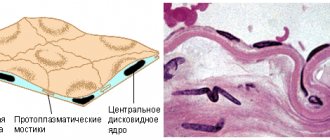Pyelonephritis
Diabetes
Hepatitis
Rheumatism
45893 October 27
IMPORTANT!
The information in this section cannot be used for self-diagnosis and self-treatment.
In case of pain or other exacerbation of the disease, diagnostic tests should be prescribed only by the attending physician. To make a diagnosis and properly prescribe treatment, you should contact your doctor. We remind you that independent interpretation of the results is unacceptable; the information below is for reference only.
Urea in the blood: indications for prescription, rules for preparing for the test, interpretation of the results and normal indicators.
The blood test showed elevated creatinine. What does it mean?
My biochemical blood test showed elevated creatinine. Please tell me what this indicator is?
Irina Stepanova, Orsha.
Creatinine is a chemical compound in the human body produced from amino acids.
It is found in animal products such as beef and fish and is also sold as a dietary supplement. Creatinine improves strength, muscle mass and athletic performance. At the beginning of the chain of transformations is creatine. This component carries out a long journey through the body, starting in the kidneys and continuing in the liver. After this, the substance is sent to the muscles, where creatine phosphate is created from creatine. The resulting component enters the muscles, giving them energy to contract. After its use, the residues enter the bloodstream and are excreted in the urine. This energy turnover occurs in the body constantly; the amount of substance in the circulatory system remains the same, provided the body is in a normal state. Professional athletes and those whose work involves heavy physical activity, as well as people on a diet or taking certain antibacterial drugs, experience a slight increase in creatinine in the blood. These are physiological reasons, they do not manifest themselves clinically and do not require special correction. A pathologically elevated level of creatinine is usually accompanied by the appearance of symptoms such as nagging pain in the lumbar region, unmotivated weakness, fatigue, drowsiness, and impaired consciousness. This symptomatology may be associated both with an increase in the supply of creatinine from the muscles, and with a violation of its excretion.
A significant increase in creatinine levels occurs in acute and chronic renal failure. Along with kidney problems, high levels are observed in severe heart failure, thyroid dysfunction, and also in certain malignant tumors that cause muscle tissue breakdown. The same effect is caused by injuries with muscle damage, burns, long-term compression syndrome, and radiation sickness.
This indicator completely depends on gender and age, as well as on kidney performance, accumulated muscle mass and food consumption preferences.
If the level of creatinine in the blood is slightly higher than normal, and the person who took the test has an athletic build and is not a person who eats only plant foods, then there is no reason to worry.
If these are elderly people, then the level of creatinine decreases, therefore, the results of the analysis simply state age-related changes in the body.
Please note that creatinine levels differ between men and women.
This can be explained by the fact that the stronger half is endowed with greater muscle mass. A slight deviation of creatinine from the norm cannot be considered a problem, since a person is in constant energy metabolism and at the next moment the excess energy can be used. But if the level of creatinine is seriously exceeded, it means that for some reason there are problems with the elimination of the substance, which led to the accumulation of creatinine in the blood and a toxic effect on the body. Olga PERESADA, Professor of the Department of Obstetrics and Gynecology of BelMAPO, Doctor of Medical Sciences.
How to evaluate kidney function? What is SCF?
A healthy kidney consists of 1-1.2 million units of renal tissue - nephrons, functionally connected to blood vessels. Each nephron is about 3 cm long, in turn, consists of a vascular glomerulus and a system of tubules, the length of which in a nephron is 50 - 55 mm, and all nephrons are about 100 km. In the process of urine formation, nephrons remove metabolic products from the blood and regulate its composition. 100–120 liters of so-called primary urine are filtered per day. Most of the liquid is absorbed back into the blood - with the exception of substances that are “harmful” and unnecessary for the body. Only 1–2 liters of secondary concentrated urine enters the bladder.
Due to various diseases, nephrons fail one after another, mostly irreversibly. The functions of the dead “brothers” are taken over by other nephrons; at first there are so many of them. However, over time, the load on efficient nephrons becomes more and more - and, having become overworked, they die faster and faster.
How to evaluate kidney function? If it were possible to accurately count the number of healthy nephrons, this would probably be one of the most accurate indicators. However, there are other methods. You can, for example, collect all the patient’s urine for a day and simultaneously analyze his blood - calculate creatinine clearance, that is, the rate of purification of this substance from the blood.
Creatinine is the end product of protein metabolism. The normal level of creatinine in the blood is 50-100 µmol/l in women and 60-115 µmol/l in men; in children these figures are 2-3 times lower. There are other normal indicators (not higher than 88 µmol/l); such discrepancies partly depend on the reagents used in the laboratory and on the development of the patient’s muscle mass. With well-developed muscles, creatinine can reach 133 µmol/l, with low muscle mass - 44 µmol/l. Creatinine is formed in muscles, so its slight increase is possible during heavy muscular work and extensive muscle injuries. All creatinine is excreted by the kidneys, approximately 1-2 g per day.
However, even more often, to assess the degree of chronic renal failure, an indicator such as GFR is used - glomerular filtration rate (ml/min).
NORMALLY GFR ranges from 80 to 120 ml/min, lower in older people. GFR below 60 ml/min is considered the onset of chronic renal failure.
Here are several formulas that allow you to evaluate kidney function. They are quite well known among specialists, I quote them from a book written by specialists from the dialysis department of the St. Petersburg city Mariinsky hospital (Zemchenkov A.Yu., Gerasimchuk R.P., Kostyleva T.G., Vinogradova L.Yu., Zemchenkova I .G. “Life with chronic kidney disease”, 2011).
This, for example, is the formula for calculating creatinine clearance (Cockcroft-Gault formula, after the names of the authors of the formula: Cockcroft and Gault):
Ccr = (140 – age, years) x weight kg/ (creatinine in mmol/l) x 814,
For women, the resulting value is multiplied by 0.85
Meanwhile, in fairness, it must be said that European doctors do not recommend using this formula to assess GFR. To more accurately determine residual kidney function, nephrologists use the so-called MDRD formula:
GFR = 11.33 x Crk –1.154 x (age) – 0.203 x 0.742 (for women),
where Crк is blood serum creatinine (in mmol/l). If the test results give creatinine in micromoles (μmol/L), this value should be divided by 1000.
The MDRD formula has a significant drawback: it does not work well at high GFR values. Therefore, in 2009, nephrologists developed a new formula for estimating GFR, the CKD-EPI formula. The results of estimating GFR using the new formula are consistent with the results of MDRD at low values, but provide a more accurate estimate at high values of GFR. Sometimes it happens that a person has lost a significant amount of kidney function, but his creatinine is still normal. This formula is too complex to present here, but it is worth knowing that it exists.
And now about the stages of chronic kidney disease:
1 (GFR greater than 90). Normal or increased GFR in the presence of a disease affecting the kidneys. Observation by a nephrologist is required: diagnosis and treatment of the underlying disease, reducing the risk of developing cardiovascular complications
2 GFR=89-60). Kidney damage with moderate reduction in GFR. Assessment of the rate of progression of CKD, diagnosis and treatment is required.
3 (GFR=59-30). Average degree of GFR decline. Prevention, detection and treatment of complications are necessary
4 (GFR=29-15). Pronounced degree of reduction in GFR. It's time to prepare for replacement therapy (a choice of method is required).
5 (GFR less than 15). Kidney failure. Initiation of renal replacement therapy.
Estimation of glomerular filtration rate by the level of creatinine in the blood (abbreviated MDRD formula):
3.How to measure creatinine clearance?
Glomerular filtration rate reflects the functioning of the kidneys. If the kidneys begin to function poorly, then creatinine clearance also decreases.
There are two main ways that doctors use creatinine to measure kidney function:
- Daily urine analysis, in which all the urine in one day is collected in a special container;
- Glomerular filtration rate can be measured using a one-time blood test, the results of which are inserted into a special formula for calculation.
Blood tests are used much more often because... it is more convenient.
Hyperparathyroidism - symptoms and treatment
Hyperparathyroidism is an endocrine disease that develops when there is an excessive amount of parathyroid hormone (parathyroid hormone) in the body, which is secreted by the parathyroid glands.

There are different forms of this disorder.
Primary hyperparathyroidism, in addition to a disorder of the parathyroid glands and excessive secretion of parathyroid hormone, is accompanied by an upper-normal or elevated calcium level in the blood. Among endocrine diseases, it is quite common: in terms of prevalence, this form of hyperparathyroidism is in third place after diabetes mellitus and thyroid pathologies.
The annual incidence of the primary form is about 0.4–18.8% of cases per 10,000 people, and after 55 years - up to 2% of cases.[6][12] This pathology occurs more often in women than in men - approximately 3:1. The predominant number of cases of primary hyperparathyroidism in women occurs in the first decades after menopause.
Primary hyperparathyroidism can be either an independent disease or combined with other hereditary diseases of the endocrine system. [1] [12] It is manifested by multi-symptom damage to various organs and systems, which leads to a significant decrease in the quality of life with subsequent disability, as well as the risk of premature death .
The causes of occurrence are associated with the development in one or more parathyroid glands of such pathologies as:
- solitary adenoma - up to 80-85% of cases;
- hyperplasia (diffuse enlargement of glands) - up to 10-15% of cases;
- cancer - up to 1-5% of cases;
- sporadic diseases - up to 90-95% of cases.
In 5% of cases, the occurrence of primary hyperparathyroidism is influenced by heredity.
In secondary hyperparathyroidism, in addition to the general clinical signs of the disease, it is characterized by a decrease in calcium and an increase in phosphorus in the blood. This form of the disease usually develops as a compensation reaction and combines increased synthesis of parathyroid hormone and changes in the parathyroid glands. As a rule, it is found in the syndrome of insufficient absorption of calcium in the small intestine, vitamin D deficiency and chronic renal failure.
Tertiary hyperparathyroidism develops in the case of parathyroid adenoma and increased secretion of parathyroid hormone in conditions of long-term secondary hyperparathyroidism.
Pseudohyperparathyroidism develops with other malignant tumors that are capable of producing a substance similar to parathyroid hormone.
Creatinine in Biochemical Analysis (CREA)
Creatinine is the result of the metabolism of complex energy-carrying molecules. These molecules are formed in the liver and are carried to all cells, delivering the energy necessary for life. Energy is released after the rupture of special chemical bonds, resulting in the formation of breakdown products that return to the blood. One part of them is reused in the synthesis of new energy carriers, and the other part is utilized by the excretory system as compounds foreign to the body. Among them is creatinine. It is always present in the blood, which indicates normal metabolism.
Energy metabolism is most active in muscle tissue (especially during physical activity), nerve cells (during mental stress) and in the gastrointestinal tract (after eating). The indicator is different for opposite sexes, since it is believed that a man has more developed muscles, harder work, and more active metabolic processes.
Norm:
- For men – 74-110 µmol/l;
- For women – 44-80;
- Children under 14 years old – 27-62;
- Children under 12 months – 18-35.
If excretion is not impaired, all “extra” creatinine is successfully utilized in the urine. Otherwise, when the kidneys cannot cope with the load and are unable to filter it out, the concentration increases. Pathology of the urinary system
is the most common cause of increased CREA.
However, excess of the norm also occurs when its formation is enhanced, despite the intact excretory function in the case of:
- Muscle damage (injuries, burns, inflammation);
- Intoxication;
- Metabolic disorders (thyrotoxicosis, diabetes mellitus);
- Massive blood loss;
- Autoimmune processes;
- Hepato-biliary diseases.
The decrease is somewhat less common and is typical for situations not associated with any pathology:
- Reducing protein in the diet (diet, fasting);
- Dystrophy, atrophy, cachexia;
- The first three months of pregnancy.
A change in normal values is not always a sign of the presence of a disease. For example, this indicator may increase after heavy physical or intense mental work, a rich meat diet, or drinking large amounts of alcohol. To exclude such false positive results:
- Determined strictly on an empty stomach;
- Reduce meat consumption the day before;
- Avoid alcohol and intense work during the day.
Creatinine level testing is mandatory
if any symptoms associated with kidney dysfunction (swelling, discomfort in the lower back, changes in urine), liver (unpleasant sensations in the right hypochondrium, bitterness in the mouth), unmotivated muscle pain occur. If you have any doubts, you should consult a doctor who can clearly determine the indications for the CREA test.
Creatinine

Creatinine is a product of the non-enzymatic breakdown of creatine and creatine phosphate, which is formed in muscles. It is excreted from the body by the kidneys.
Research method
Kinetic method (Jaffe method).
Units
μmol/L (micromoles per liter).
What biomaterial can be used for research?
Venous, capillary blood.
How to properly prepare for research?
- Do not eat for 12 hours before the test.
- 30 minutes before the analysis, eliminate physical and emotional stress.
- Do not smoke for 30 minutes before donating blood.
General information about the study
Creatinine is a residual product produced in muscles when a substance called creatine is broken down. Creatine is part of a cycle that provides the body with energy to contract muscles. After 7 seconds of intense physical activity, creatine phosphate is converted to creatine, which then turns into creatinine, which is filtered in the kidneys and excreted in the urine. Creatine and creatinine are stably produced by our body in constant quantities. Almost all creatinine is excreted by the kidneys, so its concentration in the blood is a good indicator of kidney function. The amount of creatinine produced depends on total body weight and, in particular, muscle mass. Therefore, for example, creatinine levels in men will be significantly higher than in women and children.
What is the research used for?
- To assess renal function.
- To assess the function of major organs and systems.
- To assess renal dysfunction and the effectiveness of its treatment.
- If the level of creatinine in the blood and urine is known, the creatinine clearance (Rehberg test) can be calculated - this test shows how effectively the kidneys filter small molecules such as creatinine from the blood.
- To calculate the glomerular filtration rate to confirm kidney damage.
What do the results mean?
Reference values (creatinine norm):
| Age, gender | Reference values |
| 13 – 15 years | 50 – 77 µmol/l |
| > 15 years old, male | 62 - 106 µmol/l |
| > 15 years old, female | 44 - 80 µmol/l |
Causes of increased creatinine levels
- Acute and chronic renal failure.
- Insufficiency of the cardiovascular system.
- Massive destruction of muscle tissue.
- Burns.
- Acromegaly.
- Gigantism.
- Hyperthyroidism.
- Dehydration.
- Excessive physical activity.
- Excessive consumption of meat products.
- Radiation sickness.
- Obstruction of the urinary tract.
- Taking nephrotoxic drugs.
- Glomerulonephritis.
- Bacterial kidney infection (pyelonephritis).
- Necrosis of the tubular epithelium (acute tubular necrosis).
- Prostate diseases causing obstruction of the urinary system.
Reasons for decreased creatinine levels
- Starvation.
- Overhydration.
- Amyotrophy.
Important Notes
The creatinine content is reduced in pregnant women by almost half due to an increase in blood volume (hypervolemia), increased blood flow in the kidneys and, accordingly, an increasing degree of filtration; all this leads to an increase in creatinine clearance (excretion in urine).
In older people, creatinine formation normally decreases; this must be taken into account when determining the severity of their kidney disease.
1.Creatinine, normal kidney function and glomerular filtration rate
Creatinine is a waste product created during the breakdown of muscle tissue. Creatinine is filtered by the kidneys and eliminated in the urine. Doctors measure creatinine in the blood to evaluate kidney function. The ability of the kidneys to retain creatinine is called creatinine clearance. Creatinine clearance helps determine the glomerular filtration rate—the rate at which blood passes through the kidneys.
Normal kidney function and glomerular filtration rate (GFR)
All blood passes through the kidneys several hundred times in one day. The kidneys push fluid through tiny filters (called nephrons). Some of the fluid and waste remains in the kidneys and makes up urine.
The rate at which blood passes through the kidneys is called the glomerular filtration rate. Glomerular filtration rate cannot be measured directly, so creatinine and creatinine clearance are used.
Reasons for increased creatinine
Physiological reasons
An increase in creatinine in the blood may be due to physiological reasons. Thus, increased creatinine is often observed in athletes, especially those who engage in powerlifting and bodybuilding (significant muscle mass).
Also, a high level is observed in people whose diet is dominated by protein foods of animal origin (meat, fish, chicken).
A separate column includes people who were forced to take certain medications (tetracycline antibiotics, cephalosporins, non-steroidal anti-inflammatory drugs: ibuprofen, diclofenac, indomethacin and others).
Pathological reasons:
- acute and chronic renal failure (kidneys cannot cope with excretory function);
- an overactive thyroid gland (thyrotoxicosis, in which the body's muscles begin to break down under the influence of excess thyroid hormones);
- cardiovascular pathology (blood circulation in the body is impaired, including in the kidneys);
- radiation sickness;
- cancerous tumors;
- dehydration of the body (dehydration);
- muscle damage (long-term compression syndrome - Crash syndrome, muscle injuries and ruptures, surgical interventions);
- major burns;
- endocrine pathology (acromegaly, gigantism);
- an increase in the blood content of a number of metabolic products (glucose, fructose, urea).
4.What to do if creatinine clearance is low?
If you have a low creatinine clearance or glomerular filtration rate, your doctor will give you the necessary recommendations.
The main causes of chronic kidney disease are high blood pressure and diabetes. If this is the reason for the low glomerular filtration rate, then you need to start eating right, playing sports and taking prescribed medications. If there are other reasons, then additional tests will be required to clarify them.
As we age, the functioning of our kidneys declines, so it is necessary to check their health regularly.









